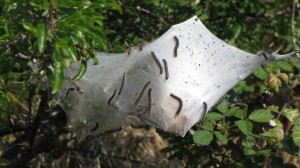View from the Hill 22nd May 2014
→click on pictures for full screen image
Lambing has been progressing steadily through the month, the weather has generally been friendly towards the sheep since they were shorn at the end of April, and on the warmer days they have been very pleased to be free of their fleeces. There has been the usual rash of orphan lambs, due to the usual reasons, lost mummy, ill mummy, dead mummy, or mummy whose teats are like sausages, too big for lambs!  The count so far is 5 bouncy little lambs, all very keen drinkers from the bottle, currently being fed four times per day. The latest addition was found shivering under a hedge this morning after 14 mm of rain and a mummy without enough milk for two. A good drink and a few hours under a hot lamp worked like magic, and she is now up and bouncing around with the others.
The count so far is 5 bouncy little lambs, all very keen drinkers from the bottle, currently being fed four times per day. The latest addition was found shivering under a hedge this morning after 14 mm of rain and a mummy without enough milk for two. A good drink and a few hours under a hot lamp worked like magic, and she is now up and bouncing around with the others.
 Keeping the lambs company in the shed is a calf, a bit of a novelty for the rearing department, he was very stubborn about feeding to start with, and took about 5 days to agree to drink from the feeder without a fight, however he is now feeding well, and looking forward to being allowed to go outside, when he can be trusted to behave himself. He has to be hand reared because he is the result of an unintended liaison between an under age mother, and a bull who should have known better, his mother would not have coped well, so we decided to bring him in.
Keeping the lambs company in the shed is a calf, a bit of a novelty for the rearing department, he was very stubborn about feeding to start with, and took about 5 days to agree to drink from the feeder without a fight, however he is now feeding well, and looking forward to being allowed to go outside, when he can be trusted to behave himself. He has to be hand reared because he is the result of an unintended liaison between an under age mother, and a bull who should have known better, his mother would not have coped well, so we decided to bring him in.
These little devils are the guzzlers responsible of stripping all the leaves off various stretches of hedge in the district, we found some here last weekend, I think it is the caterpillar of the brown tail or ermine moth. In previous years they have damaged a lot of local hedges, particularly noticeable on the A354 on the way to Salisbury, these are the first I have seen this year. For some reason they are not attractive to birds, otherwise they wouldn’t last long at all. The web is quite sticky, and the caterpillars very hairy.
The show of wild flowers this spring has been utterly spectacular, the cowslips, bluebells, wild garlic, campion, cow parsley and many others have been flowering brightly for weeks. I found these flowers which I have yet to identify, in a paddock nearby, they open wide in the sunshine, and close up tight at night. Initial research suggests some kind of lily.
There cannot be a prettier place to split logs than in this bluebell wood, or a smellier place than amongst this wild garlic……. 
In the henhouse, there is always a rush to be the first in the manger in the morning. Even though the hens have a very smart nest box to lay in, they are always happier to lay in the old manger in the corner. One day last week I found four of them queuing up:  We only have six hens, and they seem to manage to produce five eggs between them on most days. I didn’t understand what makes them decide what time of day to lay, and whether they do so at the same time every day, and several other imponderables, so let’s ask Mr Google:
We only have six hens, and they seem to manage to produce five eggs between them on most days. I didn’t understand what makes them decide what time of day to lay, and whether they do so at the same time every day, and several other imponderables, so let’s ask Mr Google:
Chickens never lay more than one egg per day. As a rule, chickens lay in the morning, but each day a little later. Sometimes the last egg of a series is produced in the early afternoon. When it gets too late, they take the next day off. My five commercial hybrids will sometimes lay for a series of 30 days or more.
1. The hen approaches the nest in a very hesitant way, and finally enters. There she sits quiet for a long time, often for half an hour or more. She closes an eye or calmly puts a straw on her back, but finally she gets more exited. Now and then, the hen raises her tail and spreads the feathers of her bottom. These movements increase gradually.
2. Under her tail, between the feathers, is a small opening called the vent. Suddenly the hen stands up with her feet wide apart, tail raised, bottom feathers spread out, and back feathers upright
3. The hen strains at intervals. Each time, the egg comes a little further out. Eventually the moist egg pops out. Sometimes it will come out blunt end first, sometimes pointed end first. The bird stands high above the egg and rests, beak open and panting after the heavy work. The entire process (from rising to dropping the egg) is quite fast and is finished within half a minute. Therefore, it is hard to observe. After a while, the hen looks back, inspects the egg with her beak and leaves the nest making loud cackles. The hen then eats and drinks and goes her usual way. She seems to have forgotten her egg completely.
So there you have it, with thanks to Wiebe H. van der Molen, clearly a keen observer of hens.
Here are some beautiful ladies we met last month on holiday :
One up, one down
Back home and silage making was soon in full swing, here are our neighbours making some lovely looking silage in ideal conditions, using a tidy team of identical tractors.
The aftermath of last January’s storms, they left a bit of a mess. Our local chainsaw expert came in one day recently to try to make sense of these turkey oaks that blew down together in Foxwarren. We are going to try out the wood with the charcoal burners when they return in the winter.





